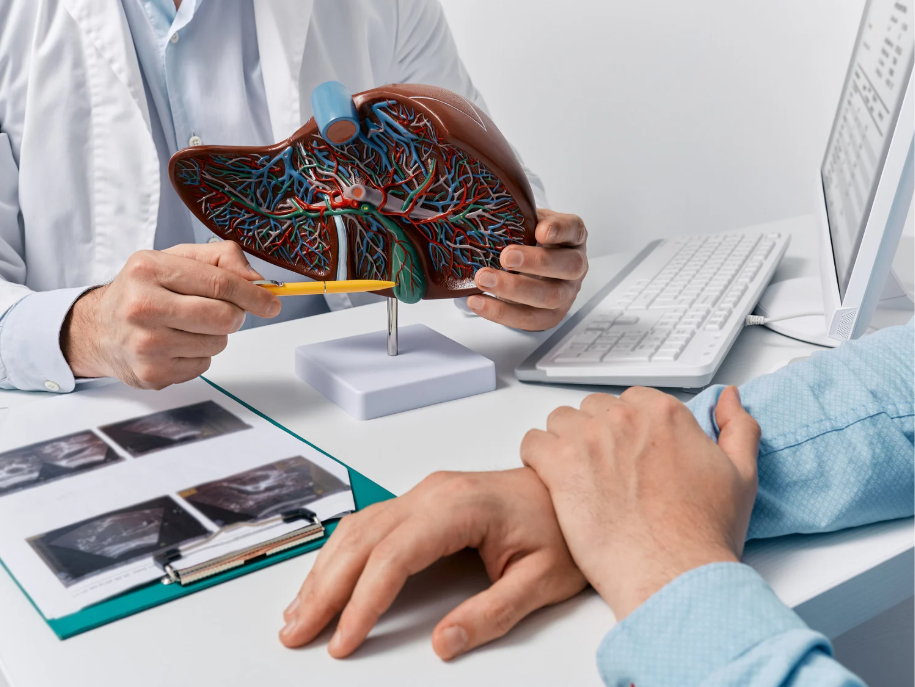Anyone with primary sclerosing cholangitis (PSC), may have heard their doctor talk about “fibrosis” or “cirrhosis” during check-ups or FibroScans (a non-invasive procedure similar to an ultrasound). These words can sound scary, but learning what they mean can help patients and their doctors make the best choices for a patient’s health. Remember that many people live active, full lives for many years with PSC.
What is liver fibrosis?
Fibrosis is the medical word for “scarring of the liver.” Just like how skin can form a scar after an injury, the liver creates scar tissue when bile ducts get inflamed in order to try to repair the damage.
Over time, fibrosis may slowly build up. The rate of progression is different for each person with PSC. Many people live with mild or moderate fibrosis, often without symptoms.
Fibrosis stages
If you have PSC, doctors may talk about fibrosis in “Stages” or use terms like “F0”, “F1”, and so on. The main system used for PSC fibrosis is called the Ludwig system while the other system used for fibrosis in general is called the METVAR system.
The Ludwig system (Stages 1-4): Mainly used for PSC
Stage 1 – Very little scarring in the corners/”entrance” areas of your liver called the portal areas.
Stage 2 – Scarring begins to spread outside of the portal areas, but the scars have not connected to each other.
Stage 3 – The scars start to connect to each other.
Stage 4 – Scars are now widespread and connected, leading to cirrhosis (permanent, “honeycomb-like” scarring)
The METVAR system (F0-F4): General for any liver disease
F0 – No fibrosis: No scarring seen
F1 – Mild fibrosis: Small regions affected.
F2 – Moderate fibrosis
F3 – Severe fibrosis: Scar areas start to connect.
F4 – Cirrhosis: Lots of scar tissue around the liver.
In the early stages of fibrosis, symptoms are usually absent. In the later stages, some early PSC symptoms may be present, such as fatigue, itching, and altered lab values from blood tests such as liver function tests (LFTs). Both systems help doctors understand the health of the liver and how best to treat it. Ask the doctor which system they use and what your current stage or score means.
What is liver cirrhosis?
Cirrhosis happens when the scar tissue has replaced much of the normal liver tissue (Ludwig Stage 4 or METVAR F4). Not all patients with PSC will develop cirrhosis. Cirrhosis itself is divided into two clinical stages. Some researchers have even divided into 4 substages:
Compensated cirrhosis is the early stage of cirrhosis where the body “compensates” for the liver damage. The liver still functions well enough, so cirrhosis symptoms are mild or not present. People still live active lives during this stage.
Portal hypertension may be present in compensated cirrhosis. With portal hypertension, the scar tissue increases pressure in a special vessel called the portal vein, which carries blood from your stomach, intestines, spleen, and pancreas to the liver for filtering. The increased pressure can cause blood to reroute through other veins to get around the liver (this is how the body “compensates”), which can stretch and weaken the vessels over time.
Substage 1 – No swollen veins (varices), no fluid buildup in the abdomen (ascites)
Substage 2 – Varices present, but no bleeding or ascites
Decompensated cirrhosis is the later stage of cirrhosis where the body cannot compensate for the liver damage due to too few healthy cells being present. At this point, symptoms will start to show up:
- Ascites
- Variceal bleeding (vomiting blood or black stools)
- Hepatic encephalopathy (confusion, sleepiness)
- Jaundice (yellowing of skin/eyes)
Substage 3 – First decompensating event (one of the symptoms from above)
Substage 4 – Repeat complications
However, treatments for these complications have improved greatly, offering many people meaningful symptom relief and improved quality of life. Some individuals even experience recompensation, where liver function improves after successful treatment. Ultimately, a transplant remains the most effective option for the advanced stages of cirrhosis as it can improve one’s health and quality of life significantly.
Stay hopeful and in close touch with your healthcare team. They are your partners in managing PSC and supporting your liver health. If you wish to reach out to others that have been impacted by PSC, please check out PSC Partners in-person and virtual (Zoom Room) support group events.



















